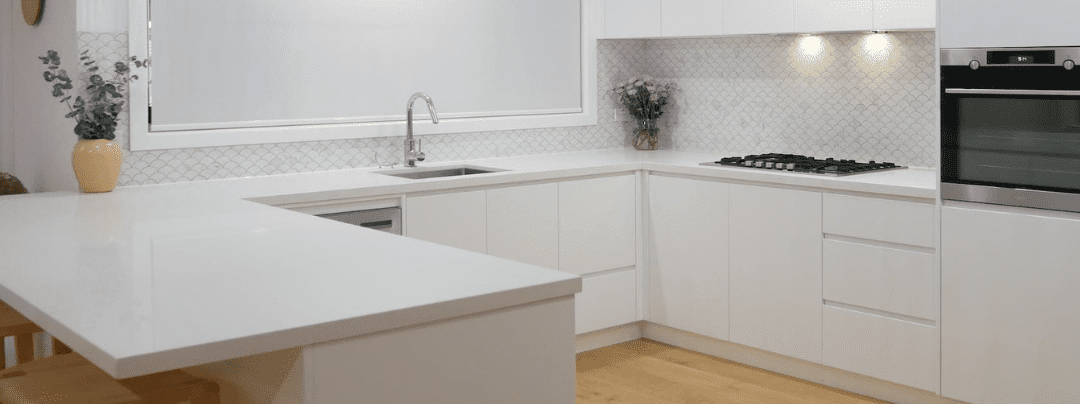When it comes to kitchen renovations, the world truly is your oyster! But in today’s fast-paced society, rapid consumption and instant results are placing immense pressure on quality!
It’s no surprise that flat-pack and store-bought kitchens have surged in popularity. They’re fast, convenient, and readily available. But when it comes to the heart of your home, is cheap and easy really what you’re after, or would you rather invest in a custom kitchen designed just for you?
It’s essential to ask yourself: Do you prefer fast food or a gourmet meal? Fast food offers quick service and often satisfies your cravings, but it can never compare to the richness of a gourmet experience.
Your kitchen is no different. While it’s tempting to opt for a quickly assembled kitchen that gets the job done. What you truly desire is a custom-built kitchen that reflects care, craftsmanship, and your unique lifestyle.
One of the most common questions we receive is, “How long does it take to renovate a kitchen?”
Let’s walk you through the process of turning your dream of a new kitchen into a reality, including what are the steps involved in a kitchen renovation project.
Kitchen Renovation: Your Complete Step-by-Step Guide
Step 1: Designing Your Kitchen
This is the most thrilling part of your kitchen renovation, allowing you to unleash your creativity and envision all the features you desire in your new space. It’s also one of the most crucial steps; taking a bit of extra time here can prevent any buyer’s regret down the line. Depending on your budget, you may find yourself going back and forth with your kitchen designer to align your vision with your financial plan.
Keep in mind that your choice of cabinetry can affect the timeline of your renovation. For instance, flat cabinets require less craftsmanship, while more intricate door profiles, like the chiefly, take additional time to embellish as the doors require detailing. Likewise, consider that most melamine comes pre-painted, whereas hand-painted options need cleaning, sanding, painting, and coating, which adds to the timeline.
The following timelines apply as a guide once an order has been check measured, finalised and booked into production:
Melamine (4 weeks): Durable, budget-friendly laminate with a smooth matte or gloss finish.
Bevel Melamine (5 weeks): Melamine doors with beveled edges for clean handleless look kitchens.
Specialised or high-end prefinished board materials (5-6 weeks): Hard wearing and feature packed prefinished materials like acrylics, wood grain melamine shaker doors, scratch and fingerprint resistant products and special textured products.
Flat Polyurethane (5 weeks): Smooth, flat doors with a tough polyurethane coating.
Sharknose Polyurethane (5 weeks): For modern ‘no handle, fingerpull option’ rounded-edge doors finished with durable polyurethane.
Pattern Polyurethane (6 weeks): Polyurethane doors with decorative patterns or textures.
Detailed Door Profiles (7 weeks): Classic raised panel doors with traditional mouldings.
Solid Timber (7 weeks): Natural hardwood doors offering warmth and durability.
Hand-painting (7 weeks): Custom hand-painted doors for a unique finish.
Brushed Hand Paint (8 -10 weeks): Hand-painted doors with a textured brushed effect.
Taking the time to plan thoroughly at this stage will set you up for a successful kitchen renovation.
Note: The kitchen design process usually takes 1 to 3 weeks. This depends on how complex your kitchen renovation is and the design choices you make.
Step 2: Removing Existing Cabinets
Once your new kitchen cabinets are ready and scheduled for delivery, it’s time to dive into your kitchen renovation. This step involves taking out your existing cabinets.
If you’re comfortable getting your hands dirty and have a skip bin for debris removal, you can tackle this yourself. But make sure to hire a licensed plumber and electrician. They can safely disconnect live wires and fix plumbing issues before you start. Depending on the size of your kitchen, the removal process should take no longer than a day.
Hot Tip: If your old cabinets are still in good shape, consider selling them online to help recover some of your renovation costs.
Step 3: The Building Work
The next stage of your kitchen renovation involves any necessary building work. If you keep everything in its current position, you won’t need to do much.
However, if you’re planning to rearrange elements such as removing a wall, relocating key appliances, needing new flooring, or adding a sink to your kitchen island that was previously on your back bench. Then you’ll need to complete this structural work before installing your kitchen cabinets or benchtop.
It’s a good idea to check with your carpenter or builder about how long they estimate the work will take. Typically, you can wrap up minor building tasks in just a day or two.
At this stage, you should have basic installations for all plumbing and electrical work. This includes wiring for your appliances and setting up new lights or power points.
Top Tip: If your kitchen manufacturer has a kitchen manufacturing license, they can coordinate trades. This means they can take responsibility and manage the timeline of your kitchen renovation better.
Note: Some builders prefer to install the flooring after the kitchen is set up. This approach can cut costs since flooring only needs to be laid around the kitchen rather than underneath it.
However, other builders choose to lay the flooring first. Installing the flooring beneath the cabinetry creates a more seamless look and can be beneficial if you decide to renovate your kitchen later on without the need to replace the floor as well.
Step 4: Installation Day for Cabinetry
This is where the excitement truly begins, and you’ll start to see your kitchen renovation come to life. The time this process takes depends on your kitchen’s size and layout. It usually takes one to three days.
Step 5: Installing Your Benchtop
If you’ve chosen laminate or solid timber benchtops for your new kitchen, they can usually be made at the same time as your cabinetry. This synchronisation allows for a seamless installation process, with both the cabinets and benchtops being fitted by the same skilled team.
For materials like granite, stone, porcelain, or stainless steel, you’ll need a specialist installer. If you check and measure everything carefully beforehand, the benchtop can be prepared early. It can then be installed right after your cabinets are in place. This kind of planning helps prevent delays, making the installation process smoother and more efficient.
Typically, manufacturing these benchtops takes about 10 working days, depending on the supplier.
Step 6: Connecting the Appliances and Plumbing
You’re just about ready to enjoy your brand-new kitchen! Once your benchtops are set up, your electrician and plumber will return. They will connect all the important appliances, like the oven, cooktop, sink, and faucets.
Harrington Tip: If you’ve opted for an under-mount sink, it’s a good idea to let the adhesive cure for 24 hours before connecting the plumbing. This will help ensure a secure and long-lasting fit.
Step 7: Adding the Finishing Touch: Your Splashback Installation
Now that your benchtops are in place, it’s time to add a stylish splashback that will breathe life into your kitchen.
If you’ve opted for a stone splashback, it can often be installed alongside your benchtops by a specialist. Giving your kitchen that polished, cohesive look right away.
For other materials such as tiles, Mirrored Splashback or pressed metal splashback. These usually go up after the benchtop is set. Installation for a splashback is generally 1 to 2 days, depending on the size and complexity of the area.
Helpful Tip: If your splashback has power points, schedule your electrician to come back after it is installed. This will finalise all connections of your kitchen renovation.
Step 8: Plastering and Painting Your Kitchen Walls
With the cabinetry, benchtops, and splashbacks in place, it’s time to pull everything together with some plastering and a fresh coat of paint.
Before you start painting, make sure to take care of any exposed wall areas. This includes spots around new cabinets or places where old fixtures have been taken out. You may need to patch or re-plaster these spots to ensure a smooth, clean surface that’s ready for a flawless paint finish.
Plastering is particularly crucial after the splashback installation to even out any rough edges or gaps, giving your space a polished appearance.
Once the plastering is finished and thoroughly dry, make sure to protect your cabinetry and benchtops with drop sheets, and tape off the edges to keep paint splashes at bay. Now you’re all set to paint, adding that final touch of style to your kitchen.
And just like that… you’re just one step away from enjoying your beautifully completed kitchen!
Step 9: Celebrate Your Beautiful New Kitchen Renovation
With your kitchen renovation finally finished, it’s time to revel in your hard work! Gather your friends and family, fire up those shiny new appliances, and whip up some delicious meals in your stunning, transformed kitchen. Take a moment to appreciate the style, comfort, and practicality that your gorgeous new kitchen adds to your home.
Thinking About a Kitchen Renovation? Streamline Your Timeline with the Right Support
Renovating a kitchen is no small feat. From planning and design to selecting materials and coordinating multiple trades, there’s a lot to manage.
If you’re considering a do-it-yourself kitchen renovation, be prepared to take on project management, scheduling, and plenty of decision-making. Another option is to work with a designer while managing the trades yourself. But again, this can be time-consuming and overwhelming without experience.
That’s where a trusted kitchen renovation company like Harrington Kitchens can make all the difference. If you’re searching for kitchen renovations near me, we offer a complete kitchen renovation package, handling every detail. From custom kitchen design and cabinetry to managing the full kitchen renovation timeline. Our team ensures a smooth, stress-free experience so you can enjoy the transformation without the hassle.
Wondering how much does a new kitchen cost? We’ve broken it all down in our blog about kitchen renovation costs, so you can plan with confidence.
For more kitchen renovation ideas, be sure to explore our kitchen design gallery or visit our kitchen showrooms in Bowral and Narellan to experience our craftsmanship firsthand. Ready to bring your dream kitchen to life? Contact us today—we’d love to help you get started.


Recent Comments